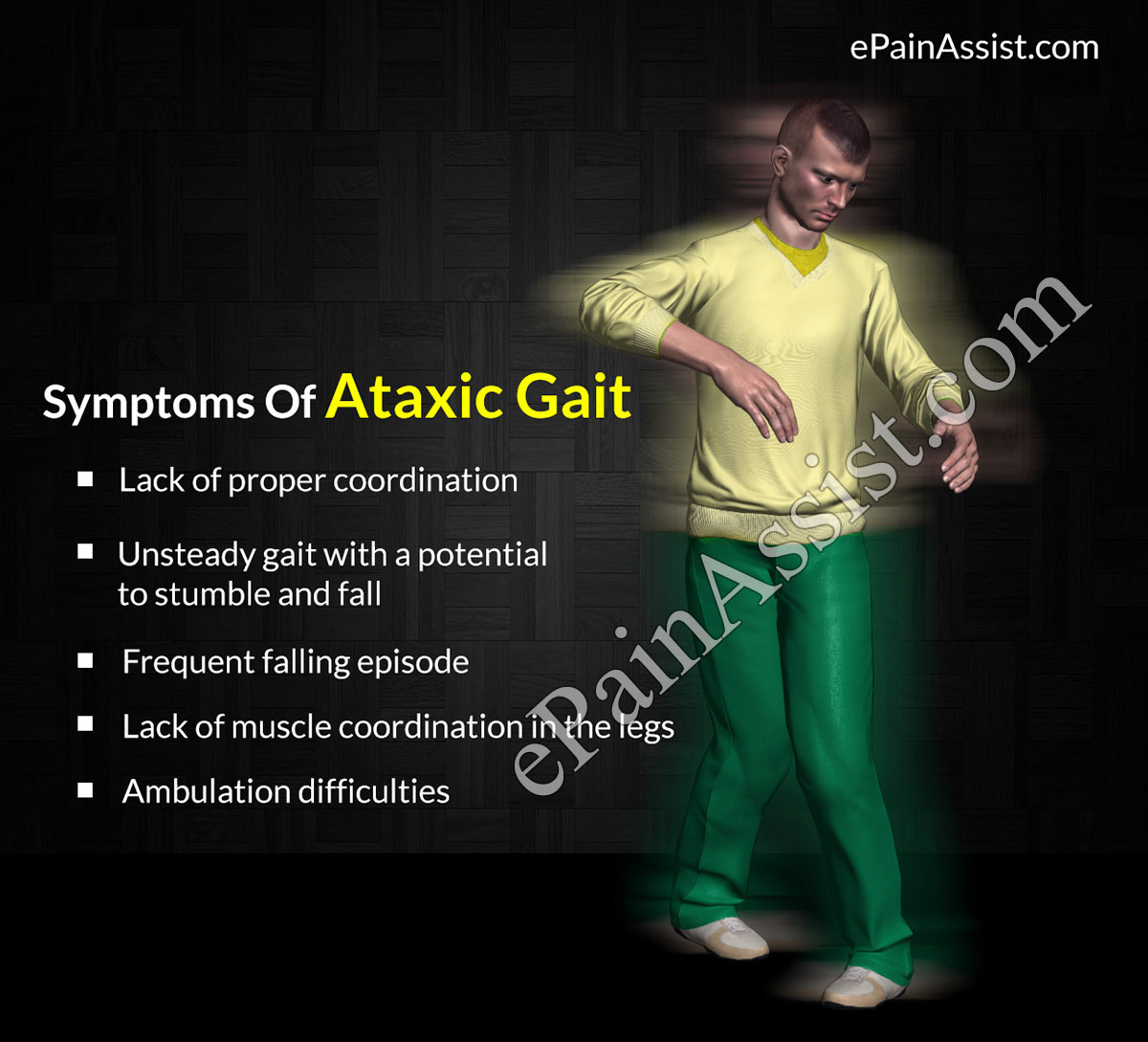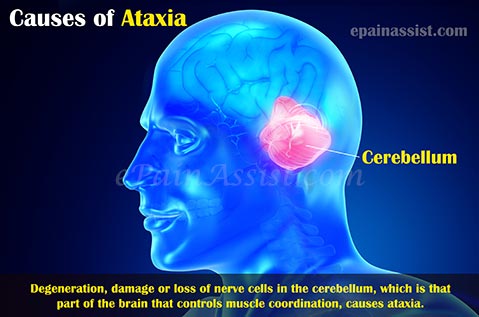Brain is divided into two sections as cerebral cortex and cerebellum. Cerebellum influences the balancing of the entire body. The balancing is maintained while lying down, sitting, walking or jogging. Balancing is achieved by contraction and relaxation of opposing muscles in the core body and extremities. Cerebellum influences the contraction and relaxation of muscles to achieve proper balance. Ataxia is a medical condition in which there is a lack of muscle coordination as a result of an injury to the cerebellum. Ataxia causes various impairments like ambulatory difficulties, swallowing problems, and other neurological complications.1 In this article we will discuss mainly about balancing and ambulatory difficulties as a result of Ataxia. The ambulatory abnormalities are condition known as Ataxic Gait or Gait Ataxia.

The cerebellum has two portions of folded tissues, which are located at the base of the brain close to the brainstem. The right side controls the muscles of the right side of the body and the left side controls the muscles of the left side of the body. An injury to the left side of the cerebellum will cause ataxia on the left side of the body and likewise for the right.
What Is Ataxic Gait Or Gait Ataxia?
- Ataxia as said is lack of muscle control when performing voluntary movements like walking or picking or grasping things.
- This condition is caused as a result of an injury to the cerebellum whose function is muscle control.
- When ataxia affects the walking pattern of an individual this condition is termed as Ataxic Gait or Gait Ataxia.
- Patients following cerebellar injury or disease have difficulty walking because of uncoordinated muscle contractions.
- Patient tries to prevent a fall by modifying gait. Patient walks with wide base and moves side to side to find the balance and prevent fall resulting in unsteadiness and irregular steps.
- Patient with Ataxic Gait or Gait Ataxia often prefers to take short steps.
Causes Of Ataxic Gait Or Gait Ataxia

- Head Injury- Traumatic head injury is observed following a car or work accident. Head injury results in sudden-onset ataxia, also known as acute cerebellar ataxia. Any injury or damage to the cerebellum results in Ataxic Gait or Gait Ataxia.
- Degenerative Changes- Degeneration of nerve cells in the cerebellum can result in Ataxic Gait or Gait Ataxia.
- Stroke- Stroke is a medical condition caused by lack of blood flow to brain. The lack of blood flow to brain results in ischemia of cerebral cortex and cerebellum.2 The isolated lack of blood supply to cerebellum causes Ataxic Gait or Gait Ataxia. The ischemia or lack of blood supply results in lack of nutrients and oxygen, which follows brain cell death.
- Transient Ischemic Attack (TIA)- TIA is a temporary decrease in blood supply to cerebellum resulting in Ataxic Gait or Gait Ataxia. The abnormalities may last for only short time.
- Multiple Sclerosis (MS)- Ataxic Gait or Gait Ataxia is observed in patients suffering with multiple sclerosis. Symptoms are more predominant in patients with established sign of multiple sclerosis.
- Cerebellar Tumor- Benign or malignant tumor of cerebellum often causes symptoms of cerebellar ataxic gait.
- Toxic Reaction- Side effects caused by barbiturates and Benzodiazepam may result in ataxia. Alcohol intoxication or heavy metal poisoning causes ataxic gate. Most common heavy metal poisoning resulting in ataxia is caused by mercury.
- Vitamin E or Vitamin B-12 Deficiency- Vitamin E or B12 deficiency causes ataxia.
- Hereditary Ataxias- Some individual are born with abnormal gene expressing ataxia and ataxic gait. There are over 20 autosomal dominant ataxic gene recognized by scientist.3
- Episodic Ataxia- In few patient ataxias last for few seconds and recovery is complete for rest of the period. Individual may get few attacks a day.
- Friedreich’s Ataxia- One of the common types of hereditary ataxia. The condition is caused by congenital cerebellum damage. The condition is also associated with damage of spinal cord and peripheral nerve.4
Symptoms Of Ataxic Gait Or Gait Ataxia
- Lack of proper coordination
- Unsteady gait with a potential to stumble and fall
- Frequent falling episode
- Lack of muscle coordination in the legs
- Ambulation difficulties
Autonomic Symptoms
- Hypotension
- Bradycardia or Tachycardia.
Non-Specific Symptoms Associated With Ataxia or Ataxic Gait-
- Fatigue
- Alcohol Use
- Anxiety or Stress
Diagnosis of Ataxic Gait or Gait Ataxia
To diagnose Ataxic Gait or Gait Ataxia, the treating neurologist will take a detailed history to identify potential causes of ataxia and will conduct a detailed neurological exam looking for balance problems, muscle coordination, and reflexes of the lower extremities. Apart from this, imaging studies may also be done in the form of CT scan or an MRI. Symptoms are non-specific or caused by ataxia and autonomic dysfunction. Autonomic dysfunction is caused by neurodegenerative ganglionopathy.5
Family History
Family history should be evaluated for ataxic disorder. Patient’s parents, sibling and close relatives are evaluated by history, examination and lab studies.
Blood tests to rule out specific deficiencies and toxins.
Investigations And Lab Studies For Ataxic Gait Or Gait Ataxia
Urine Examination-
- Urine screen for mercury exposure
Blood Examination-
- Vitamin E level in blood
- Thyroid gland studies to evaluate cerebellar function.
- Blood Copper Level- Rule out Wilson’s Disease
Image Studies-
- Brain Imaging: Magnetic Resonance Image (MRI) or Computed Tomogram (CT)- Test is performed to check the brain ischemic changes, brain damage and brain tumor.
- Spinal Cord- Possible neuroimaging of the spinal cord to rule out multiple sclerosis and spinal degenerative diseases.
- Chest and Abdomen- X-Ray and CT scan of chest and abdomen to diagnose the primary tumor.
Electrophysiological Testing-
- Electromyography- Muscle functions are checked to evaluate neuromuscular diseases.
- Nerve Conduction Velocity Testing – The test is performed to evaluate nerve degenerative diseases.
- Electroencephalography (EEG)- EEG studies are performed to evaluate brain function and abnormalities.
Treatment For Ataxic Gait Or Gait Ataxia
Some Of The Treatments For Ataxic Gait Or Gait Ataxia Are:
Conservative Treatment For Ataxic Gait or Gait Ataxia-
- Extensive Physical Therapy
- Gait Training Exercises
- Use of Orthotics
- Use of walkers and cane for balance and support
Medications For Ataxic Gait or Gait Ataxia-
- Acetazolamide
- 5-hydroxytryptophan (5-HTP)
- Idebenone
- Trimethoprim–sulfamethoxazole
- Physostigmine
- L-carnitine or derivatives
- Vigabatrin, phosphatidylcholine
- 4-aminopyridine, buspirone
- Vitamin E
Precautions For Ataxic Gait Or Gait Ataxia
Gait Training plays a very important role in Ataxic Gait or Gait Ataxia. An ataxic individual will have lack of proper balance and coordination resulting in improper foot placements resulting in frequent falls.
- Proper Positioning- Practice placing the feet correctly while walking and change of position from sitting to standing and standing to walking.
- Walking on Treadmill- Exercise on treadmill can be unsafe. Start by walking on a treadmill at a slow pace. Once placement of feet is corrected, then other parameters like stride length and stance phase can be adjusted for proper balance.
- Cane or Walker- One can also try using cane or walker during ambulation or activities.
Supportive Therapy For Ataxic Gait or Gait Ataxia-
- Neurorehabilitation
- Occupational Therapy
- Speech Therapy
- Swallowing Therapy
- Adaptive Equipment
- Driver Safety Training
- Nutritional Counseling
Also Read About Other Type Of Gait Disorders:
- Unsteady Gait: What Can Cause Abnormal Gait In Person?
- Antalgic Gait: Treatment, Causes, Symptoms
- Trendelenburg Gait or Hip Drop: Exercises To Overcome Dropped Hip
References:
1. Cerebellar Ataxia
Perlman SL.
Curr Treat Options Neurol. 2000 May;2(3):215-224.
2. Cerebellar theta burst stimulation in stroke patients with ataxia.
Bonnì S, Ponzo V, Caltagirone C, Koch G.
Funct Neurol. 2014 Apr 7:1-5. [Epub ahead of print]
3. The autosomal dominant spinocerebellar ataxias: emerging mechanistic themes suggest pervasive Purkinje cell vulnerability.
Hekman KE1, Gomez CM2.
J Neurol Neurosurg Psychiatry. 2014 Aug 18. pii: jnnp-2014-308421.
4. A study of up to 12 years of follow-up of Friedreich ataxia utilising four measurement tools.
Tai G1, Corben LA2, Gurrin L3, Yiu EM4, Churchyard A5, Fahey M6, Hoare B5, Downie S5, Delatycki MB7.
J Neurol Neurosurg Psychiatry. 2014 Aug 11. pii: jnnp-2014-308022.
5. Autonomic dysfunction is a major feature of cerebellar ataxia, neuropathy, vestibular areflexia ‘CANVAS’ syndrome.
Wu TY1, Taylor JM2, Kilfoyle DH3, Smith AD4, McGuinness BJ4, Simpson MP3, Walker EB3, Bergin PS3, Cleland JC3, Hutchinson DO3, Anderson NE3, Snow BJ3, Anderson TJ5, Paermentier LA6, Cutfield NJ7, Chancellor AM8, Mossman SS2, Roxburgh RH9.
Brain. 2014 Jul 28. pii: awu196.
Also Read:
- Unsteady Gait: What Can Cause Abnormal Gait In Person?
- Optic Ataxia: Causes, Symptoms, Treatment
- Ataxia: Causes, Signs, Symptoms, Treatment, Types, Diagnosis
- Friedreich’s Ataxia: Causes, Signs, Symptoms, Treatment, Prognosis, Prevention
- Spinocerebellar Ataxia: Causes, Symptoms, Diagnosis, Treatment, Life Expectancy
